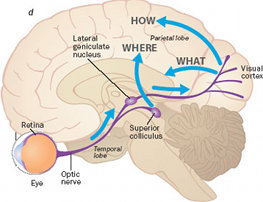
Credit: Melissa Thomas
Most folks have trouble separating the eye and sight.
But if you think about it, sight really does not happen in the eye… it takes place in the BRAIN.
On a rudimentary level:
- We SEE a mixture of borders, shades and colors.
- We have to process them to appreciate them as shapes and forms.
- FURTHER processing is needed in order to identify
- WHAT the form is, and
- WHERE the form is, and
- to discriminate the figure from the background.
In fact, most of what we appreciate visually is the result of a much greater VISUAL PROCESS.
We seldom see the world as it is… the world we see is a projection of ourselves, based on our interests– in general and in the moment.
Try this Experiment:
Clear your mind, and take in the room around you. Got it?
Good.
Now, before you take a second look, consider this word:
BLUE
Now look again…
Did that change what you noticed?
~~
Now, before you take a third look, consider this word:
YELLOW
Now look a third time…
Did that change your perception?
For many of us, a simple priming of a concept (or color) will result in a change in what we take in. We do not SEE anything different or new, but we change what we PERCEIVE! We even change WHERE we place our attention!
Eye Problems vs Vision Problems
Many people consider the eyes as the most critical factor in our sight. But as the above experiment demonstrates, what we see with our eyes can be readily modified!
The eyes are the sensors through which information is collected for a much more complex VISUAL PROCESS.
The seat of control for these sensors is THE BRAIN (in general terms).

In order to use our eyes EFFICIENTLY as SENSORS, the BRAIN sends neurological signals to the eyes regarding:
- Where to aim the two eyes in the visual field
- How much vergence or eye teaming energy to apply (that is, to make the two eyes aim in the same direction for single vision)
- How much focusing power to apply (in order to see clearly)
- How fast to move the eyes in order to keep them aimed at the target of interest
- In which direction to move the eyes, to pursue a steadily moving target
- How much energy to apply to jump the eyes to the next target of interest, looking elsewhere
That’s a lot of work!
And all of this takes place in order to simply collect visual information which is CLEAR and SINGLE, for further information processing!
In our next segment, we will consider what happens in the VISUAL PROCESS… with or WITHOUT the use of the eyes as sensors!


I enjoyed reading your blog. My only change would be to change your word “sight” to “vision”. For me sight happens in the eye, if we need to improve sight we provide spectacles etc. Vision happens in the brain, where we make sense of the information provided by our eyes.
Thank you for your comment, Donovan. I’m glad you enjoyed the read.
I must respectfully disagree with your comment, as both “sight” and “vision” occur in the brain. The blog piece discusses “visual information processing” as a much larger umbrella term, including the details and resolution provided by “eyesight.”
Spectacles often do not improve sight, but rather move the images to a location in space where the eye is in better focus. Typically, spectacles are compensatory. In their best scenario, they can be therapeutic, inviting the two eyes to coordinate with greater ease. We often say it is not what the lens does to the eye, but what an eye (rather, brain) does with a lens. In that regard, it seems we are in agreement: Vision (visual information processing) happens in the brain, where we make sense of the information provided *through* our eyes… not *by* our eyes.